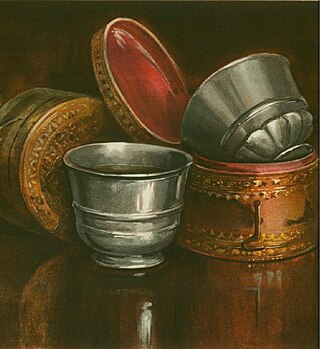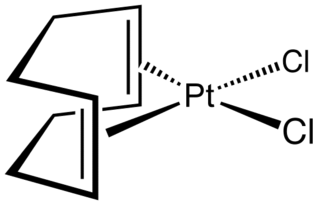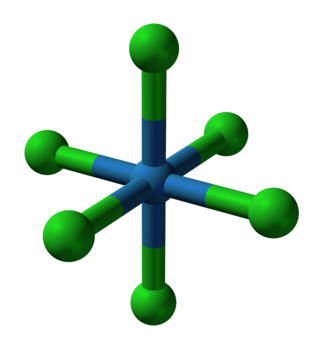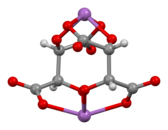
Antimony is a chemical element; it has symbol Sb (from Latin stibium) and atomic number 51. A lustrous gray metalloid, it is found in nature mainly as the sulfide mineral stibnite (Sb2S3). Antimony compounds have been known since ancient times and were powdered for use as medicine and cosmetics, often known by the Arabic name kohl. The earliest known description of the metalloid in the West was written in 1540 by Vannoccio Biringuccio.

Tartaric acid is a white, crystalline organic acid that occurs naturally in many fruits, most notably in grapes, but also in bananas, tamarinds, and citrus. Its salt, potassium bitartrate, commonly known as cream of tartar, develops naturally in the process of fermentation. It is commonly mixed with sodium bicarbonate and is sold as baking powder used as a leavening agent in food preparation. The acid itself is added to foods as an antioxidant E334 and to impart its distinctive sour taste. Naturally occurring tartaric acid is a useful raw material in organic chemical synthesis. Tartaric acid, an alpha-hydroxy-carboxylic acid, is diprotic and aldaric in acid characteristics, and is a dihydroxyl derivative of succinic acid.

Potassium tartrate, dipotassium tartrate or argol has formula K2C4H4O6. It is the potassium salt of tartaric acid. It is often confused with potassium bitartrate, also known as cream of tartar. As a food additive, it shares the E number E336 with potassium bitartrate.

Succimer, sold under the brand name Chemet among others, is a medication used to treat lead, mercury, and arsenic poisoning. When radiolabeled with technetium-99m, it is used in many types of diagnostic testing. A full course of Succimer lasts for 19 days of oral administration. A second course should be given when more than two weeks pass after the first course.

Antimony oxychloride, known since the 15th century, has been known by a plethora of alchemical names. Since the compound functions as both an emetic and a laxative, it was originally used as a purgative.

An antimonial cup was a small half-pint mug or cup cast in antimony popular in Europe during the 17th and 18th centuries. They were also known under the names "pocula emetica," "calices vomitorii," or "emetic cups", as wine that was kept in one for a 24‑hour period gained an emetic or laxative quality. The tartaric acid in the wine acted upon the metal cup and formed tartarised antimony.

Vanadium(III) chloride describes the inorganic compound with the formula VCl3 and its hydrates. It forms a purple anhydrous form and a green hexahydrate [VCl2(H2O)4]Cl·2H2O. These hygroscopic salts are common precursors to other vanadium(III) complexes and is used as a mild reducing agent.

Dichloro(1,5-cyclooctadiene)platinum(II) (Pt(cod)Cl2) is an organometallic compound of platinum. This colourless solid is an entry point to other platinum compounds through the displacement of the cod and/or chloride ligands. It is one of several complexes of cycloocta-1,5-diene.

Croconic acid is a chemical compound with formula C5H2O5 or (C=O)3(COH)2. It has a cyclopentene backbone with two hydroxyl groups adjacent to the double bond and three ketone groups on the remaining carbon atoms. It is sensitive to light, soluble in water and ethanol and forms yellow crystals that decompose at 212 °C.
John Brian Christopherson CBE, was a British physician and a pioneer of chemotherapy.
Hexaphenylcarbodiphosphorane is the organophosphorus compound with the formula C(PPh3)2 (where Ph = C6H5). It is a yellow, moisture-sensitive solid. The compound is classified as an ylide and as such carries significant negative charge on carbon. It is isoelectronic with bis(triphenylphosphine)iminium. The P-C-P angle is 131°. The compound has attracted attention as an unusual ligand in organometallic chemistry.

Terbium(III) nitrate is an inorganic chemical compound, a salt of terbium and nitric acid, with the formula Tb(NO3)3. The hexahydrate crystallizes as triclinic colorless crystals with the formula [Tb(NO3)3(H2O)4]·2H2O. It can be used to synthesize materials with green emission.

Potassium telluride is an inorganic compound with a chemical formula K2Te. It is formed from potassium and tellurium, making it a telluride. Potassium telluride is a white powder. Like rubidium telluride and caesium telluride, it can be used as an ultraviolet detector in space. Its crystal structure is similar to other tellurides, which have an anti-fluorite structure.
A chloride sulfite or sulfite chloride is a chemical compound that contains chloride and sulfite anions (SO32− Cl−). The known compounds of this type are all late transition metal sulfito complexes. Chlorine may be present as a ligand (chloro) or as an ion (chloride). The sulfito ligand can connect to the metal atom by way of an oxygen, or a sulfur atom. It can also link to the metal atom using two oxygen atoms as a bidentate ligand.

In chemistry, a transition metal chloride complex is a coordination complex that consists of a transition metal coordinated to one or more chloride ligand. The class of complexes is extensive.
Titanium(IV) acetate or titanium tetraacetate is a hypothetical coordination complex with the formula Ti(C2H3O2)4. It is discussed in archaic literature, well before the advent of X-ray crystallography and an appreciation of the structural trends in metal carboxylate complexes.
A nitrate nitrite, or nitrite nitrate, is a coordination complex or other chemical compound that contains both nitrite and nitrate anions (NO3− and NO2−). They are mixed-anion compounds, and they are mixed-valence compounds. Some have third anions. Many nitrite nitrate compounds are coordination complexes of cobalt. Such a substance was discovered by Wolcott Gibbs and Frederick Genth in 1857.
An iodide nitride is a mixed anion compound containing both iodide (I−) and nitride ions (N3−). Another name is metalloiodonitrides. They are a subclass of halide nitrides or pnictide halides. Some different kinds include ionic alkali or alkaline earth salts, small clusters where metal atoms surround a nitrogen atom, layered group 4 element 2-dimensional structures, and transition metal nitrido complexes counter-balanced with iodide ions. There is also a family with rare earth elements and nitrogen and sulfur in a cluster.
Iodide hydrides are mixed anion compounds containing hydride and iodide anions. Many iodide hydrides are cluster compounds, containing a hydrogen atom in a core, surrounded by a layer of metal atoms, encased in a shell of iodide.
Bromoantimonates are compounds containing anions composed of bromide (Br−) and antimony (Sb). They can be considered as double bromides, metallohalides or halometallates. They are in the category of halopnictates. Related compounds include the bromobismuthates, iodoantimonates, bromophosphates, and bromoarsenates.



















